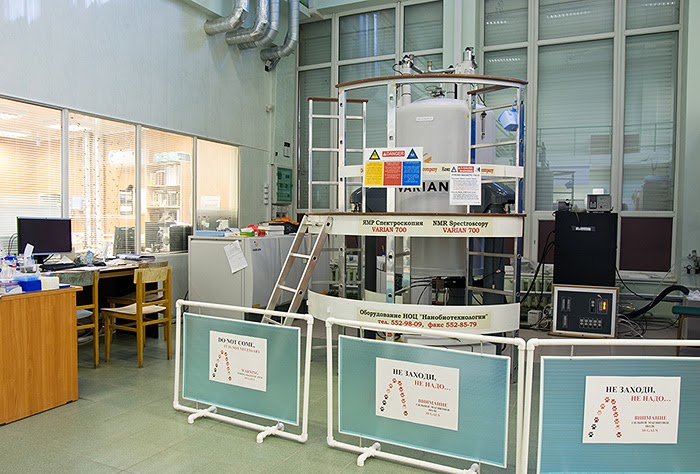
NMR spectrometer Varian DirectDrive NMR System 700 Mhz
- Inverse salt-tolerant triple-resonance probe (1H/13C/15N)
- Inverse broadband triple-resonance probe (1H/{15N-31P}/13C)
- Broadband direct observation probe {15N-31P}/1H
- All probes are equipped with Z-gradient coils, a lock channel, and are designed for 5 mm sample tubes.
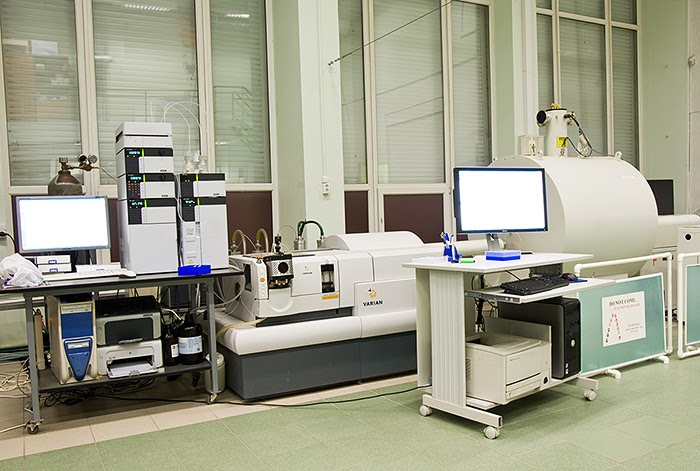
Fourier transform ion cyclotron resonance mass spectrometer FTMS with two ion sources: electrospray and MALDI (FT-ICR MS 9.4 Tesla, Varian, USA)
Ultra-high resolution mass spectrometer for composition and structure analysis of macromolecules (mass range: 500-4500 m/z). Features CID, ECD, and IRMD ion dissociation modes.
902-MS ion source parameters:
- Mass accuracy: <2 ppm at m/z 1046 (Angiotensin II)
- Resolution: 250,000 at m/z 1046 (Angiotensin II)
- Sensitivity: 50:1 (S/N ratio) for 100 fmol Angiotensin II at m/z 1046
910-MS ESI ion source parameters:
- Mass accuracy: <1.5 ppm at m/z 403.2 (Cortisone-21-Acetate)
- Resolution: 490,000 at m/z 403.2 (Cortisone-21-Acetate)
- Sensitivity: 50:1 (S/N ratio) for 5 fmol reserpine at m/z 609
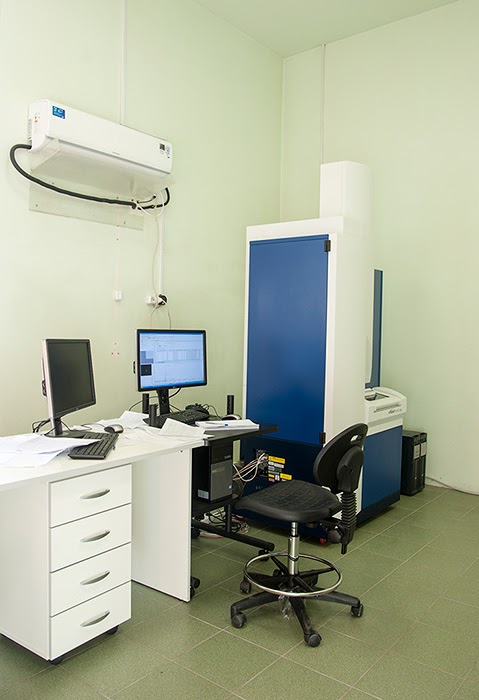
AB Sciex 5800 MALDI TOF-TOF mass spectrometer
Time-of-flight mass spectrometer with three operational modes:
- Reflectron mode (mass range 800-4000 m/z): mass accuracy <30 ppm at m/z 2093 (ACTH (clip 1-17)), resolution >24000 at m/z 2093, resolution >15000 at m/z 1296 and m/z 3657, sensitivity >500 for 100 fmol ACTH (clip 1-17) at m/z 2093, sensitivity >100 for 250 amol Neurotensin at m/z 1672
- MS/MS mode (mass range up to 4000 m/z) for Glu-Fibrinopeptide B fragments (mass accuracy ~0.05-0.1 Da, resolution >3000, sensitivity >500 for 75 fmol (Glu-Fibrinopeptide B), sensitivity >30 for 1.5 fmol (Angiotensin I);
- Linear mode (low masses (mass range 800-4000 m/z): mass accuracy 500 ppm, resolution >3000, sensitivity >200 for 5 fmol; mid mass range 4000-20000 m/z: accuracy 0.05%, resolution >500, sensitivity >200 for 3 fmol; high mass range 20000-140000 m/z: sensitivity >80 for 3 fmol 66430 m/z (BSA).
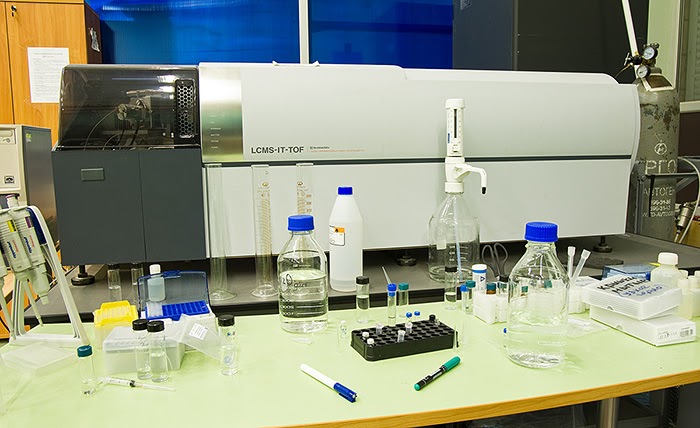
LCMS-IT-TOF chromatograph-mass spectrometer (Shimadzu, Japan)
- MSn analysis up to MS10
- Resolution 8000-10000 depending on mass range
- Mass measurement error ≤5 ppm in all operation modes: MS, MS/MS, and MS/MS/MS
- Sensitivity for reserpine in MS2 mode: 5 pg with S/N ratio 50:1
- Spectrum acquisition time <100 milliseconds
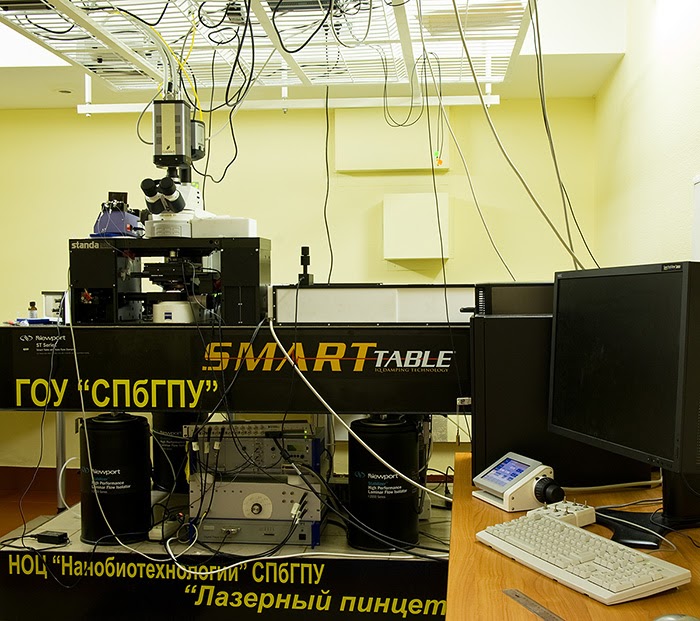
FA-1 Nanomachine Dynamics Research System
FA1 is a system based on the Carl Zeiss Axio Imager Z1 research microscope. FA1 enables unique single-molecule biophysical experiments using optical trapping (or laser tweezers, English: optical trapping or optical tweezers). Laser tweezers are widely used to study interactions between individual biological molecules, such as DNA-protein interactions (investigation of transcription, translation, replication, and repair processes), as well as the dynamics of protein-protein interactions (particularly the study of motor proteins). This method allows precise measurement of interaction forces between studied molecules at a level characteristic of intracellular processes. Additionally, optical trapping enables manipulation of living cells, for example, to study the mechanical properties of cells and their components. Besides optical trapping, the FA1 system incorporates fluorescence microscopy methods, including super-resolution microscopy (English: super-resolution microscopy, PALM, STORM).
The system serves as the foundation for a unique integrated setup for studying nanobiomachine dynamics (CF «Laser Tweezers»).
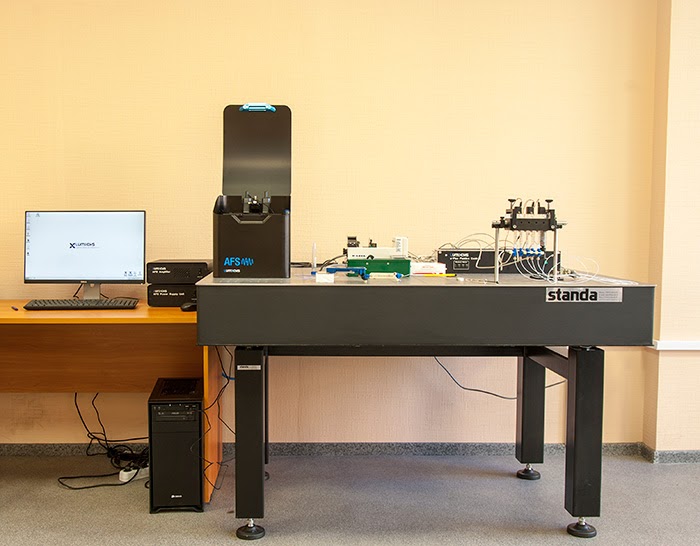
The equipment complex for single-molecule studies based on a surface acoustic wave spectrometer (acoustic nanotweezers)
The system provides real-time manipulation and precision position measurement of biomolecules under acoustic wave excitation with forces ranging from fractions to hundreds of piconewtons and sub-millisecond resolution. When measuring biomolecule positions, the following parameters are achieved: with simultaneous measurement of 400 molecules in 3D space, the positioning accuracy is no worse than 3 nanometers; with simultaneous measurement of 2000 molecules in 2D space, the accuracy is no worse than 2 nanometers; the minimum force increment per single molecule is no more than 2 femtonewtons; the maximum applied force per single molecule is no less than 100 piconewtons; the rate of change of applied force to molecules covers a range from 10⁻⁴ to 10³ piconewtons per second.
The complex is part of the unique integrated system for studying nanobiomachine dynamics (CF «Laser Tweezers»)
Femtosecond laser system RAPOP-100 (AVESTA, Russia)
The RAPOP-100 femtosecond system consists of a Ti:Sa laser and a regenerative amplifier.
Laser parameters:
- Generation wavelength: 800 nm
- Pulse repetition rate: 80 MHz
- Pulse duration: 50 fs
- Output power: 400 mW
Regenerative amplifier parameters:
- Wavelength: 800 nm
- Pulse repetition rate: 3 kHz
- Pulse duration: 50 fs
- Pulse energy: 100 μJ
The laser system is part of the unique integrated setup for studying nanobiomachine dynamics (CF «Laser Tweezers»).
Nikon Ti biomedical microscope with digital camera
The microscope enables a wide range of biological structure visualization tasks: fluorescence microscopy (including super-resolution microscopy), long-term automated live-cell imaging (time-lapse microscopy), as well as routine visualization.
- High-sensitivity sCMOS camera with 4.2-megapixel sensor
- Incubation system (temperature control)
- Nikon Perfect Focus System (PFS) for continuous focus maintenance
- 5 fluorescence channels (DAPI, CFP, YFP, RFP, Texas Red)
- Wide selection of air and immersion objectives
- Compatible with Petri dishes and multi-well plates
The microscope is part of the unique integrated system for studying nanobiomachine dynamics (CF «Laser Tweezers»).
Plate reader spectrophotometer CLARIOstar BMG LABTECH GmbH
The CLARIOstar BMG LABTECH GmbHmicroplate spectrophotometer features bottom-reading and ultra-fast absorbance spectroscopy in UV-Vis range, with capabilities: fluorescence polarization measurement for wavelengths above 350 nm, dual reagent injectors, sample incubation up to 65°C, luminescence detection in up to 384-well plates, and time-resolved fluorescence measurements.
Sample preparation equipment complex
The complex is part of the unique integrated system for studying nanobiomachine dynamics (CF «Laser Tweezers»).
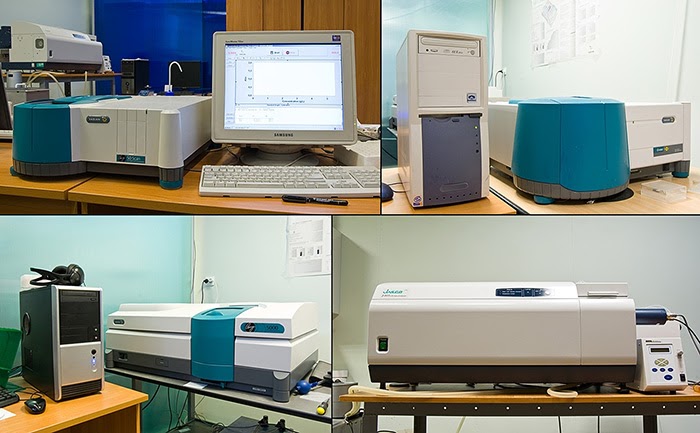
Optoelectronic instrumentation complex for physicochemical analysis of biological samples:
- Fluorometer Cary Eclipse (with BioMelt accessory kit)
- Scanning spectrophotometer Cary 50
- Spectrophotometer Cary 5000 (175-3300 nm)
- CD spectrometer Jasco J-815
High-performance centrifuge for biological sample separation Avanti J-30i (Beckman Coulter)
(with rotor set JS-24.15, JS-24.38, JA-18, JA-18.1, JA-21, JA-30.50);
Equipment for thermostating and creating vacuum conditions for biological sample preparation and research:
- Circulating liquid thermostat С10-ВЗ Thermo (Haake);
- Water bath Elmi ТW-2.02;
- Vacuum membrane pump Millipore;
- High-efficiency vacuum/pressure pump Millipore
Equipment for preparation of cell cultures and animal tissues for protein fraction isolation:
- Autoclave Tuttnauer 3850 M;
- Shaker-incubator BBI CERTOMAT BS-1;
- Potter S homogenizer;
- Ultrasonic homogenizer LABSONIC-P;
- Hollow fiber concentrator UPL by NPC Biotest;
- Freeze dryer Labconco FreeZone 2.5 L (USA).
Electromechanical instrument complex for separating heterogeneous mixtures into components of varying density in biological samples:
- High-capacity refrigerated centrifuge Hermle Z 513 K;
- Refrigerated microcentrifuge Centurion Scientific K2080R;
- Centrifugal DNA concentrator CentriVap Labconco (USA).
Water treatment equipment using distillation and membrane filtration methods:
- Distiller GFL2004;
- Bidistiller GFL2104;
- Bench-top ultrapure water system Millipore Milli-Q.
Equipped laboratories for biochemical and molecular biology research
Chromatography
- Chromatograph Akta Purifier 10 (GE Healthcare)
Chromatograph LC 20 Prominence XR (Shimadzu)
Protein expression equipment complex
- Shaker-incubator for thermophilic bacteria growth Thermotron (Infors)
- Shaker-incubator for mesophiles growth with cooling unit and phototrophs module Multitron Pro (Infors)
- Dry bath thermostat BD 53 (Binder) – 3 units
- Large-capacity autoclave 5050 ELV (Tuttnauer)
- Anaerobic chamber Bactron 300-2 (Sheldon Manufacturing) with built-in 37°C incubator; gas mixture: 5% H2, 5% CO2, 90% N2
Real-time PCR amplifier CFX96 Touch Real-Time System (Bio-Rad)
PCR workstation UVC/T-M-AR (BioSan) for sample preparation
Multifunctional centrifuges 5804 R (Eppendorf) with rotors F-34-6-38, A-2-DWP
Refrigerated floor centrifuge Sorvall RC 12BP Plus Large Capacity Centrifuge with H-12000 Bioprocessing bucket rotor (6×2000 ml tubes, Vmax=4,700 rpm (7,340×g))
Multifunctional gel documentation system ChemiDoc MP (Bio-Rad)
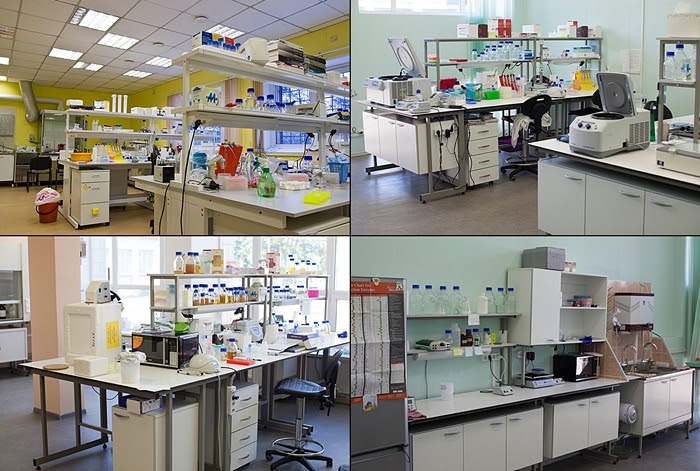
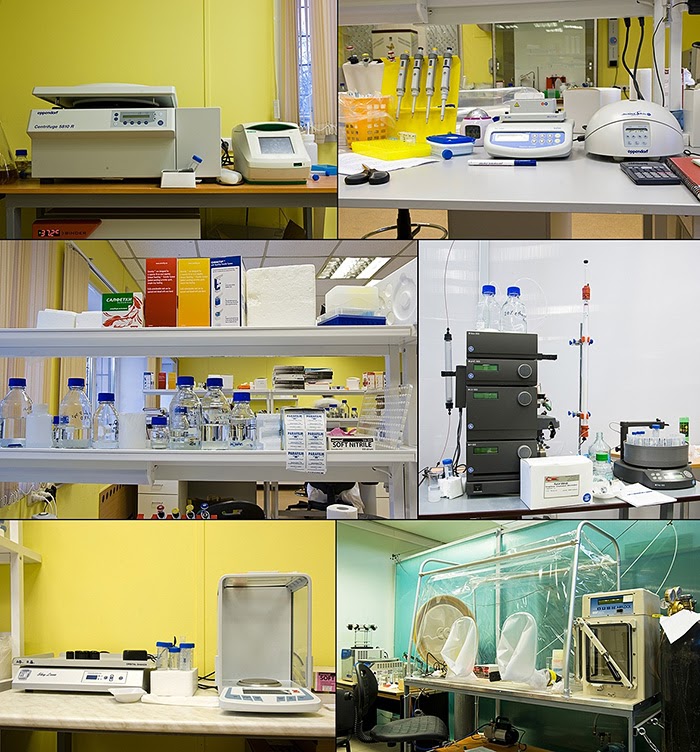
The set also includes other equipment for molecular biology and biochemical work.

